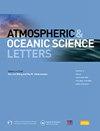利用地面观测网络数据评估 WRF-Solar 在中国夏季某月的模拟性能
IF 3.2
4区 地球科学
Q3 METEOROLOGY & ATMOSPHERIC SCIENCES
引用次数: 0
摘要
太阳能是从化石燃料向碳中和过渡的关键清洁能源。然而,太阳辐射的间歇性和随机性给精确模拟和预测带来了挑战。准确模拟和预测太阳辐射及其变异性是优化太阳能利用的关键。本研究利用WRF-Solar模式于2022年6月25日至7月25日进行了模拟实验,以评估模拟中国各地太阳辐射的准确性和性能。模拟覆盖全国,网格间距为27 km,并与中国生态系统研究网络地面观测数据进行对比。结果表明,WRF-Solar模型能够准确地捕捉中国地区全球水平辐照度的时空格局,但仍存在对太阳辐射的高估和对总云量的低估。均方根误差为92.83 ~ 188.13 Wm−2,平均偏差(MB)为21.05 ~ 56.22 Wm−2。模拟结果显示,青藏高原拉萨的MB最小,而中国东南部的MB最大。为了提高太阳辐射模拟的精度,作者将太阳全天快速辐射模型与大气环流快速辐射传输模型进行了比较,发现前者能更好地模拟太阳辐射。本研究使用WRF-Solar模式对中国2022年6月25日至7月25日的太阳辐射情况进行了深入模拟,模式网格水平分辨率为27公里,通过与中国生态系统研究网络(CERN)的地面观测网络数据的37个观测站点进行对比,以评估模式性能。结果表明:WRF-Solar模式能较好地捕捉到中国上空的辐照度全球健康行动计划(全球水平照度)的时空分布特征,但存在高估太阳辐射量,以及低估总云量的情况。全国的总辐射模拟均方根误差范围为92.83 - -188.13 W m−2,平均偏差范围为21.05 - -56.22 W m−2。青藏高原拉萨站的偏差最小, 在中国东南部的偏差最大. 为了进一步提升太阳辐射模拟的精确度,本研究还对比了农场与RRTMG辐射方案,发现农场方案的模拟精度更高。本文章由计算机程序翻译,如有差异,请以英文原文为准。
Evaluation of the simulation performance of WRF-Solar for a summer month in China using ground observation network data
Solar energy is a pivotal clean energy source in the transition to carbon neutrality from fossil fuels. However, the intermittent and stochastic characteristics of solar radiation pose challenges for accurate simulation and prediction. Accurately simulating and predicting solar radiation and its variability are crucial for optimizing solar energy utilization. This study conducted simulation experiments using the WRF-Solar model from 25 June to 25 July 2022, to evaluate the accuracy and performance of the simulated solar radiation across China. The simulations covered the whole country with a grid spacing of 27 km and were compared with ground observation network data from the Chinese Ecosystem Research Network. The results indicated that WRF-Solar can accurately capture the spatiotemporal patterns of global horizontal irradiance over China, but there is still an overestimation of solar radiation, and the model underestimates the total cloud cover. The root-mean-square error ranged from 92.83 to 188.13 and the mean bias (MB) ranged from 21.05 to 56.22 . The simulation showed the smallest MB at Lhasa on the Qinghai–Tibet Plateau, while the largest MB was observed in Southeast China. To enhance the accuracy of solar radiation simulation, the authors compared the Fast All-sky Radiation Model for Solar with the Rapid Radiative Transfer Model for General Circulation Models and found that the former provides better simulation.
摘要
准确模拟和预测太阳辐射及其变化对于优化太阳能利用至关重要. 本研究使用WRF-Solar模式对中国2022 年 6 月 25 日至 7 月 25 日的太阳辐射情况进行了深入模拟, 模式网格水平分辨率为27 km, 通过与中国生态系统研究网络 (CERN) 的地面观测网络数据的37个观测站点进行对比, 以评估模式性能. 结果表明: WRF-Solar模式能较好地捕捉到中国上空的辐照度GHI (Global Horizontal Irradiance) 的时空分布特征, 但存在高估太阳辐射量, 以及低估总云量的情况. 全国的总辐射模拟均方根误差范围为92.83–188.13 W m−2, 平均偏差范围为21.05–56.22 W m−2. 青藏高原拉萨站的偏差最小, 在中国东南部的偏差最大. 为了进一步提升太阳辐射模拟的精确度, 本研究还对比了FARMS与RRTMG辐射方案, 发现FARMS方案的模拟精度更高.
求助全文
通过发布文献求助,成功后即可免费获取论文全文。
去求助
来源期刊

Atmospheric and Oceanic Science Letters
METEOROLOGY & ATMOSPHERIC SCIENCES-
CiteScore
4.20
自引率
8.70%
发文量
925
审稿时长
12 weeks
 求助内容:
求助内容: 应助结果提醒方式:
应助结果提醒方式:


